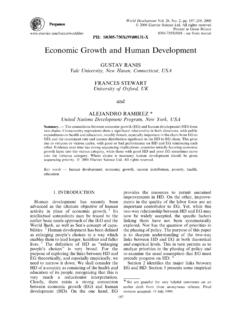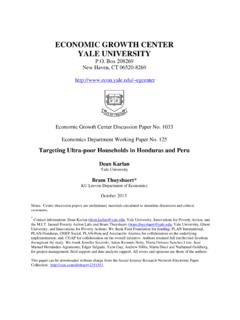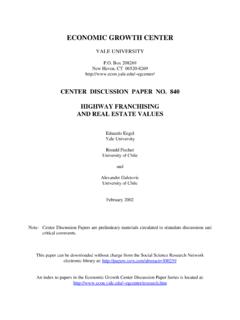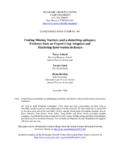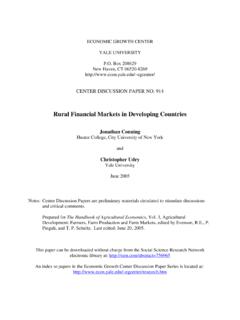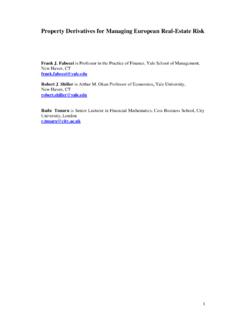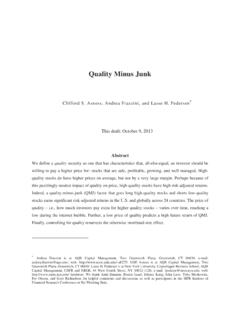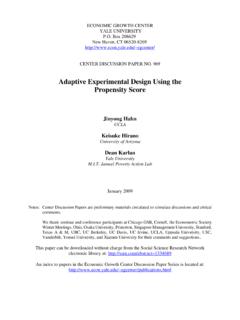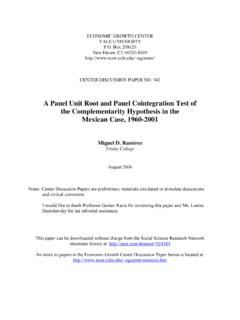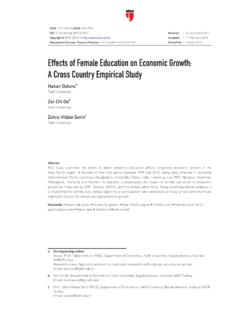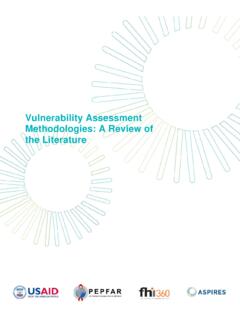Transcription of DICE 2013R - Yale University
1 DICE 2013R : Introduction and User's Manual William Nordhaus with Paul Sztorc Second edition October 2013. Copyright William Nordhaus 2013. First edition: April 2013. Website: 1. Table of Contents (New materials are with *). I. Preface (*) .. 3. II. DICE and RICE Models as Integrated Assessment Models .. 4. A. Introduction to the models .. 4. B. Objectives of Integrated Assessment Models (IAMs) .. 5. III. Detailed Equations of the DICE- 2013R Model .. 6. A. Preferences and the Objective Function .. 6. B. Economic Variables .. 8. C. Geophysical sectors .. 15. D. The RICE-2010 Model .. 19. E. Interpretation of Positive and Normative Models (*).
2 21. F. Consistency with the IPCC Fifth Assessment Report (*) .. 22. IV. Results from the DICE- 2013R Model (*) .. 24. A. Scenarios .. 24. B. Major Results (*) .. 25. V. The Recommendation for a Cumulative Emissions Limit (*) .. 35. VI. Revisions from earlier vintages (*) .. 36. A. Data and structural revisions (*) .. 36. B. Revisions to the discount rate (*) .. 37. VII. Impacts of the Revisions (*).. 38. A. Last round of revisions (*) .. 38. B. Revisions in the DICE model over the last two decades (*) .. 42. VIII. Computational and algorithmic aspects (*) .. 48. A. Analytical background (*) .. 48. B. Solution concepts (*).
3 49. C. Software architecture (*) .. 51. IX. Conclusion (*) .. 54. X. References .. 55. XI. Appendix A. Nuts and Bolts of Running the Models (*) .. 65. XII. Appendix B. GAMS Code for Different Vintages of the DICE Model .. 83. A. 1992-1994 version of DICE model .. 83. B. 1999 version of DICE model .. 86. C. 2008 version of DICE model .. 90. D. 2013R version of DICE model (*).. 96. 2. I. Preface (*) 1. The present manual combines a discussion of the subject of integrated assessment models (IAMs) of climate-change economics, a detailed description of the DICE model as an example of an IAM, and the results of the latest projections and analysis using the DICE- 2013R model.
4 The main focus here is an introduction to the DICE- 2013R model (which is an acronym for the Dynamic Integrated model of Climate and the Economy). The 2013. version is a major update from the last fully documented version, which was the DICE-2007 model (Nordhaus 2008). The purpose of this manual is to explain in a self-contained publication the structure, calculations, algorithmics, and results of the current version. Some of the materials has been published in earlier documents, but this manual attempts to combine the earlier materials in a convenient fashion. The author would like to thank the many co-authors and collaborators who have contributed to this project over the many decades of its development.
5 More than any single person, my colleague and co-author Tjalling Koopmans was an intellectual and personal inspiration for this line of research. I will mention particularly his emphatic recommendation for using mathematical programming rather than econometric modeling for energy and environmental economics. Other important contributors have been George Akerlof, Lint Barrage, Scott Barrett, Joseph Boyer, William Brainard, William Cline, Jae Edmonds, Ken Gillingham, Charles Kolstad, Tom Lovejoy, Alan Manne, Robert Mendelsohn, Nebojsa Nakicenovic, David Popp, John Reilly, Richard Richels, John Roemer, Tom Rutherford, Jeffrey Sachs, Leo Schrattenholzer, Herbert Scarf, Robert Stavins, Nick Stern, Richard Tol, David Victor, Martin Weitzman, John Weyant, Zili Yang, Janet Yellen, and Gary Yohe, as well as many anonymous referees and reviewers.
6 We have denoted sections or chapters that are largely new materials with asterisks. This will be helpful for those familiar with earlier versions or writings who would like to move quickly to the new material. Those who would like access to the model and material can find it at 1 William Nordhaus is Sterling Professor of Economics, Department of Economics and Cowles Foundation, Yale University and the National Bureau of Economic Research. Email: mailing address: 28 Hillhouse Avenue, New Haven, CT 06511. Paul Sztorc is Associate in Research, Yale University . Email: Research underlying this work was supported by the National Science Foundation and the Department of Energy.
7 Source file: 3. II. DICE and RICE Models as Integrated Assessment Models A. Introduction to the models The DICE model (Dynamic Integrated model of Climate and the Economy) is a simplified analytical and empirical model that represents the economics, policy, and scientific aspects of climate change. Along with its more detailed regional version, the RICE model (Regional Integrated model of Climate and the Economy), the models have gone through several revisions since their first development around 1990. The prior fully documented versions are the RICE-2010 and DICE-2007 model. The present version is an update of those earlier models, with several changes in structure and a full updating of the underlying data.
8 This section draws heavily on earlier expositions Nordhaus (1994, 2008, 2010, 2012), along with Nordhaus and Yang (1996) and Nordhaus and Boyer (2000). The DICE- 2013R model is a globally aggregated model. The RICE-2010 model is essentially the same except that output, population, emissions, damages, and abatement have regional structures for 12 regions. The discussion in this manual will focus on the DICE model, and the analysis applies equally to the RICE model for most modules. The differences will be described later. The DICE model views the economics of climate change from the perspective of neoclassical economic growth theory (see particularly Solow 1970).
9 In this approach, economies make investments in capital, education, and technologies, thereby reducing consumption today, in order to increase consumption in the future. The DICE model extends this approach by including the natural capital of the climate system. In other words, it views concentrations of GHGs as negative natural capital, and emissions reductions as investments that raise the quantity of natural capital (or reduce the negative capital). By devoting output to emissions reductions, economies reduce consumption today but prevent economically harmful climate change and thereby increase consumption possibilities in the future.
10 Figure 1 shows a schematic flow chart of the major modules and logical structure of the DICE and RICE models. 4. Fossil fuel use generates CO2. emissions Carbon cycle: redistributes around atmosphere, oceans, etc. Climate system: change in radiative warming, precipitation, ocean currents, sea level rise, . Impacts on ecosystems, agriculture, diseases, skiing, golfing, . Measures to control emissions (limits, taxes, subsidies, ). 2. Figure 1. Schematic flow chart of a full integrated assessment model for climate change science, economics, and policy _____. B. Objectives of Integrated Assessment Models (IAMs). IAMs can be divided into two general classes policy optimization and policy evaluation models (this distinction was emphasized in an excellent chapter of the IPCC report by Weyant et al.)
